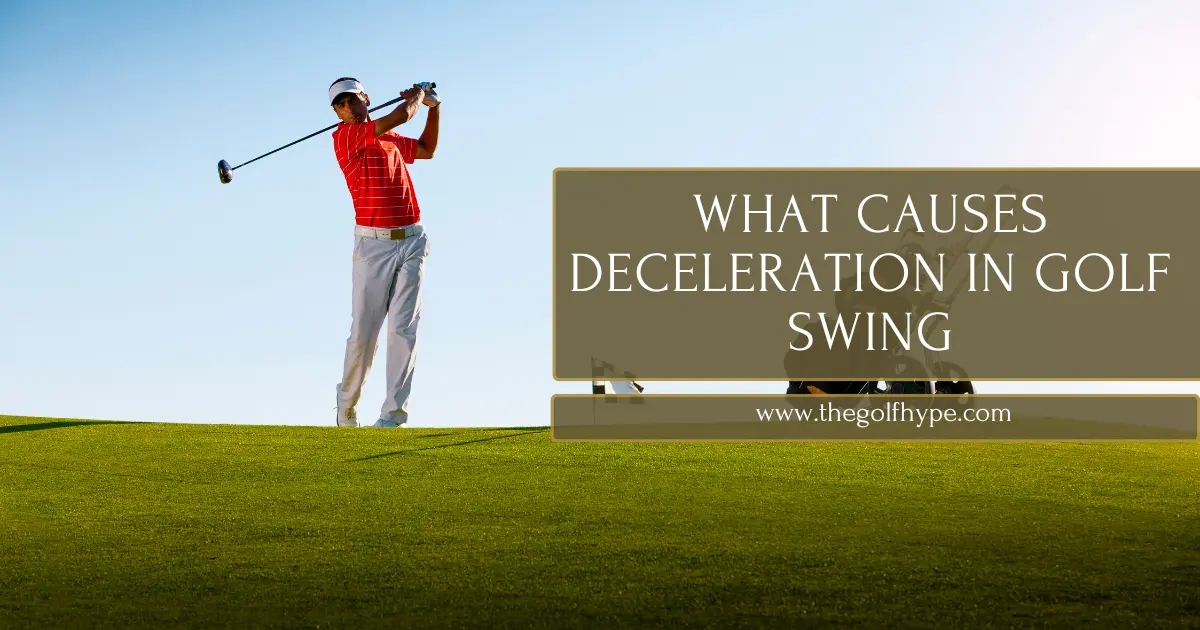When considering the reasons for deceleration in golf swing, it is important to note that several factors can contribute to this issue. One major cause of deceleration is an improper transition from the backswing to the downswing. This can result in a loss of club head speed and ultimately a decrease in the distance and accuracy of the shot.
Additionally, a lack of confidence or hesitancy in the swing can also lead to deceleration, particularly in high-pressure situations such as a pitch shot or when playing a short game. To prevent deceleration, it is crucial for golfers to focus on maintaining a smooth and fluid motion throughout the entire swing. It is essential to properly shift your weight from the back foot to the front foot and to ensure that the club head accelerates through the impact zone.




By practicing proper technique and maintaining confidence in your swing, golfers can work to stop decelerating and improve their overall performance on the course.
Improper Weight Shift
Improper weight shift can have a detrimental impact on your golf swing. When you fail to transfer your weight properly during the swing, you may find yourself decelerating your swing, resulting in a loss of power and accuracy. Additionally, an improper weight shift can also lead to a faulty swing plane, which can further hinder the quality of your shot.
This issue can be especially evident when executing a chip shot or utilizing a wedge, as the delicate nature of these shots requires precise weight transfer for successful execution. Furthermore, a poor weight shift can also be problematic when attempting to escape a bunker, as it can impede your ability to hit the ball with the necessary force and control.
In order to improve your golf game, it is essential to correct any issues with your weight shift and ensure that you are properly transferring your weight throughout your swing for consistent, effective shots.
Casting the Clubs
When casting the golf clubs, it becomes crucial to start to think about the shoulder turn and how it affects the entire swing. The slower the club is at the top of the backswing, the more control and power one will have when bringing the club toward the ball. This will create speed and ultimately lead to better control of distance and accuracy.
Additionally, it is important to pay attention to any swing flaws that may be present, as these can greatly impact the kinematic sequence of the swing. By addressing these issues and focusing on a smooth transition from backswing to downswing, one can improve the overall consistency and effectiveness of their shots.
Overall, casting the golf clubs requires a keen focus on technique and proper execution in order to achieve optimal results on the course.
Overactive Upper Body
An excessively active upper body can also result in deceleration issues. If the upper body exerts excessive force during impact, it can cause the motion to slow down. The hands and club will naturally attempt to decelerate to compensate for this.
Emphasize maintaining a smooth and leisurely backswing motion. Initiate the downswing by shifting the hips and allowing the shoulders and arms to follow suit. Rather than using the hands and arms to control it, let the club naturally shallow out. Maintain a light grip pressure to prevent tension that can lead to deceleration before impact.
Flipping the Wrists
The act of flipping entails forcefully releasing the wrists during impact in order to generate force. Although this may initially increase the speed of the clubhead, it often leads to a decrease in speed as the clubface rotates open.
To sustain speed during impact, maintain the wrist hinge for a slightly longer period before releasing. Ensure that the clubface remains square at impact, rather than opening up. Allow the larger muscles in the shoulders and core to drive the swing while keeping the wrists and hands relaxed.
Poor Rotation
Restricted upper torso rotation can hinder the generation of the force needed for optimal clubhead speed. If the backswing lacks depth and involves limited shoulder movement, it becomes challenging to transition into a powerful downswing.
Concentrate on executing broad, extensive turns during the initial and backward movement of the swing. Transfer weight onto the right side during the backswing, then propel the hands forward as you approach impact while completely rotating the hips. Establishing resistance between the upper and lower body will assist in sustaining momentum through the impact area.
Fear of the Full Swing
Sometimes deceleration is caused by tension, anxiety or fear issues within the full golf swing. Subconscious reactions can cause golfers to guide or hold back the club approaching impact.
If emotional factors seem involved, take some time to make smooth, fear-free swings. Start with short swings and partial shots to rebuild a flowing, relaxed motion. When comfort level improves, begin extending the backswing gradually while maintaining acceleration into the ball. Removing fear and doubt is key to unleashing the full power of the swing.
Improper Sequence
In order to achieve proper acceleration into impact, it is crucial that the downswing follows a specific sequence. This sequence should begin from the ground up, starting with the hips, followed by the torso, shoulders, arms/hands, and finally the club head.
If the sequence becomes disordered, for example, if the upper body or arms lead the downswing, deceleration may result. To address this issue, it is recommended to practice swinging with a focus on initiating the movement with the lower body, allowing the clubhead to follow slightly behind. Engaging in swing drills with a narrow stance can help solidify the correct firing pattern.
Faulty Transition Move
When making a faulty transition move in golf, it can greatly impact your swing through impact and the transfer of energy toward the target. The transition move is crucial in maintaining speed and power during the swing, and a mistake in this area can lead to a loss of control and distance. If the transition move is not executed properly, it may result in a deceleration of the club, rather than actually decelerating and then accelerating towards the target.
This can lead to a loss of speed and power, ultimately affecting the distance the ball travels. It is important to ensure that the transition move allows for a smooth transfer of energy, rather than causing the club to slow down. By avoiding a faulty transition move, golfers can maintain control over their swing, preventing the loss of distance and accuracy in their shots.
Lack of Lag in Downswing
Lag, in golf, is defined as the act of maintaining the angle of the wrist hinge as the clubhead nears impact. This action creates significant torque between the clubhead and grip, resulting in maximum speed. Skilled players utilize lag to forcefully propel the clubhead through impact.
However, for lag to be effective, it is crucial that the clubhead closely aligns with the hands as it approaches the ball. If the clubhead lags too far behind, the power of lag is diminished, leading to deceleration. It is important to focus on shallowing the shaft on the plane during the transition so that the clubhead catches up to the hands at impact.
FAQs
How do you accelerate in the golf swing?
To accelerate the club in the golf swing, focus on proper weight shift and sequence. During the transition, bump the hips forward to shift weight onto the front side. Uncoil the torso before unleashing the arms and club. Use ground forces and rotational momentum to build speed rather than muscling with your arms and hands. Maintain lag by keeping the wrists hinged approaching impact. Lag creates leverage for maximum acceleration through the hitting zone.
How do you stop decelerating on-chip shots?
Deceleration on chip shots is usually caused by tense hands and poor weight shift. Maintain a light and relaxed grip pressure. Shift your weight forward during the downswing to avoid getting stuck on your back foot. Allow your body to turn through impact, keeping the club accelerating down towards the ball. Practice some chips intentionally releasing the club early and letting your body pull it through contact. This trains the proper sequence for acceleration.
How do you increase acceleration in golf?
Some tips to increase acceleration in the golf swing: Utilize ground forces by maintaining pressure into your front foot during the downswing; Keep the club shallow approaching impact so the handle leads the clubhead; Maintain lag by delaying wrist hinge as long as possible; Increase rotational speed by making wider turns during the backswing and downswing; Improve sequencing by starting the downswing with your lower body; Don’t muscularly manipulate the club with your hands and arms.
Why have I lost so much swing speed?
There are several possible reasons you may have lost swing speed:
- Getting older and losing flexibility
- Developing bad swing habits that involve deceleration
- Casting the club or flipping the wrists too early
- Not shifting your weight fully onto the front side during the downswing
- Gripping the club too tight
- Moving your head or straightening up during the swing.
Take some lessons to identify swing flaws. Work on flexibility. Make smooth swings focusing on proper sequencing to rebuild lost speed.
Bottom Line
The deceleration in a golf swing can be attributed to several factors, as discussed with a swing instructor. One common cause is the failure to start the downswing with the lower body, which can lead to a loss of power and momentum. Another issue that may cause deceleration is the inability to properly transfer weight from the back foot to the front foot, causing the swing to slow down before contact with the ball. It is imperative to ensure that the initial movement of the downswing is initiated from the lower body, rather than the arms or upper body.
Deceleration can also happen right away if the golfer does not complete the backswing, as this results in a lack of momentum going into the downswing. To avoid deceleration early in the downswing, golfers should focus on allowing the arms and club to fall naturally as they start the downswing, and continue to accelerate the club through contact with the ball. By addressing these issues, golfers can effectively eliminate deceleration in their swings and generate more power and speed.
